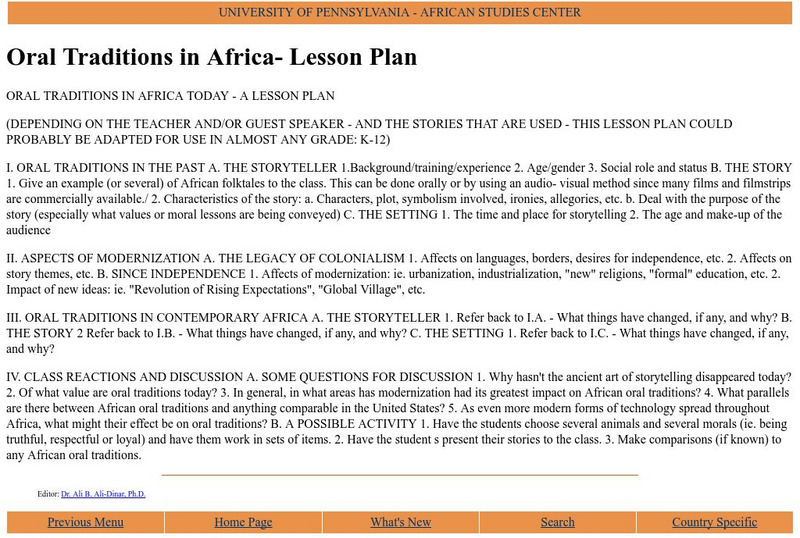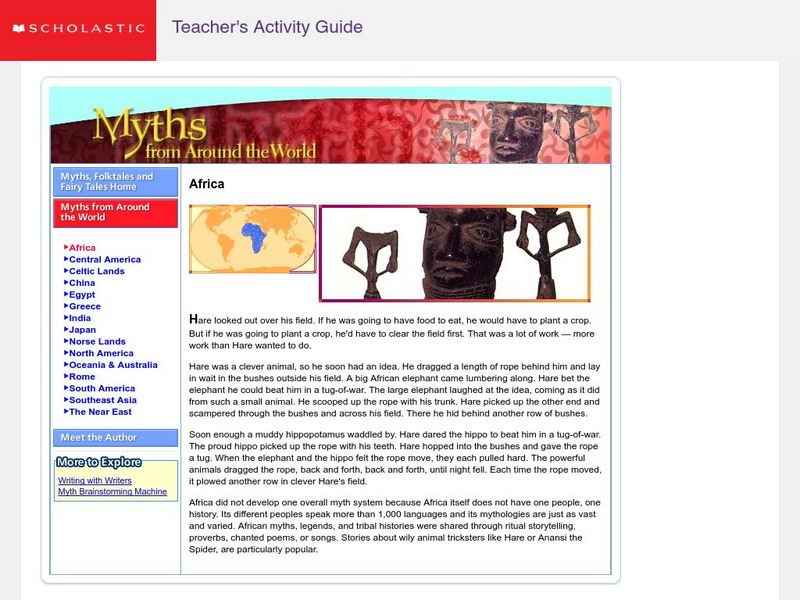Other
Central Oregon Community College: African Storytelling
This essay provides an excellent explanation of the importance of storytelling and what the author refers to as "orature," oral tradition as opposed to "literature" or written tradition. Clear examples are provided, including several...
National Endowment for the Humanities
Neh: Edsit Ement: Storytelling:the Meaning Behind the Mask
In many cultures, masks are used in oral story telling. Many learning activities are described on this site that will help students learn aspects of story telling and the different ways various cultures used masks.
National Gallery of Art
National Gallery of Art: Children's Guide: The Art of Romare Bearden [Pdf]
A colorful, printable packet, from the National Gallery of Art, for students studying the work of Romare Bearden. Includes images of his work, including his well-known collages. Investigates all the important aspects of Bearden's work:...
PBS
Pbs: A World of Stories: Anansi and the Hat Shaking Dance
Donna Washington tells a traditional West African story about Anansi the spider. The story explains why spiders don't have hair.
University of Pennsylvania
Upenn: Oral Traditions in Africa (Lesson Plan)
This website features a lesson plan that can be used by teachers K-12 on oral traditions found in Africa.
National Endowment for the Humanities
Neh: Edsit Ement: Family and Friendship in Quilts
Quilts, in addition to being a great thing to have to cuddle up on the couch with, have historically been used to tell stories and bring friends and families together. This lesson plan leads students through a series of activities on...
Scholastic
Scholastic: Myths From Around the World: Africa
Learn about Hare the wily animal trickster from the African myth. Discover how Africa spreads myths, legends, and tribal history throughout storytelling.
Countries and Their Cultures
Countries and Their Cultures: Pokot
During the colonial period, the Pokot were called "Suk" by Europeans. To some Pokot, the older designation is a reminder of an era in which Africans lacked the power to name themselves; to others, it represents the clever ruse of a...
A&E Television
History.com: How Early Humans Survived the Ice Age
The most recent ice age peaked between 24,000 and 21,000 years ago, when vast ice sheets covered North America and northern Europe, and mountain ranges like Africa's Mt. Kilimanjaro and South America's Andes were encased in glaciers. At...


![National Gallery of Art: Children's Guide: The Art of Romare Bearden [Pdf] Graphic National Gallery of Art: Children's Guide: The Art of Romare Bearden [Pdf] Graphic](https://d15y2dacu3jp90.cloudfront.net/images/attachment_defaults/resource/large/FPO-knovation.png)

